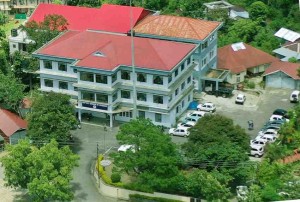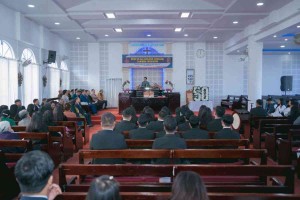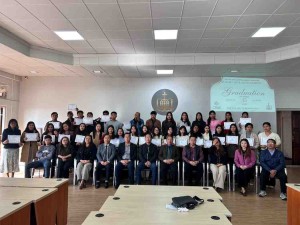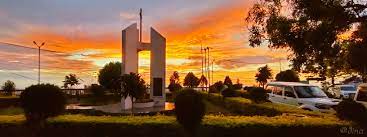The Advent of Christianity in Mizoram:
The Mizos (then known as Lushais) were a fierce tribe and they had a habit of raiding their neighbouring places in Assam before the British government subdued them. In one of such raids they killed Mr. James Winchester, a tea-gardener of Alexandrapore and they carried off his six years old daughter Mary Winchester, on January 23, 1871. When Robert Arthington, a wealthy person of Leeds and a mission enthusiast came to know about this, he had a great burden to reach those savage people of the North East India with the gospel of Jesus Christ. After sometime, in 1889, he happened to meet St.John Dalmas, a BMS missionary working in Bengal, who told him that the hill tribes of North East India have not yet been reached with the gospel.
This deeply touched him and he formed his own missionary society called ‘Arthington Aborigine Mission’ in 1889, with a particular focus of working among the savage people in the North East India. In 1890 he sent out three missionaries and one of them was J.H.Lorrain. He sent out two more missionaries in the following year who were soon followed by two more missionaries. Among them was F.W.Savidge. After a few years he sent out six more missionaries. Thus, altogether Arthington sent out thirteen missionaries. He appointed St. John Dalmas to be the supervisor over all of them. Among the thirteen missionaries sent out by Arthington, only Savidge and Lorrain emerged as successful missionaries very much known in this part of the world.
J.H.Lorrain arrived in Kolkata in January, 1891. He stayed with St. John Dalmas in Brahmanbaria (now in Bangladesh) for sometimes. They tried to get permission to work in Tripura from the Maharajah of Tripura, but they were not successful.
Around this time, William Williams, a Welsh Presbyterian missionary working in the Khasi Hills, visited some of the Mizo chiefs in the Sylhet prison, who were arrested and imprisioned by the British troops for they attacked the British forts in Aizawl and Changsil. When William Williams came to know about the Mizos from his visit of those Mizo chiefs in prison, his heart was filled with passion to preach the gospel among them but his assignment was to work among the Khasis. Moreover, the British administration in Mizoram did not allow any missionaries or visitors enter into Mizoram at that time the Mizo chiefs were still very hostile.
However, he could obtain a special permission to visit Mizoram, to survey Mizoram for the proclamation of the gospel, and he came along with the British troops. He reached Aizawl on 20th March 1891, and he was allowed to stay only up to April, 17th, 1891 (27 days). He was not allowed to go beyond Aizawl, which was the centre of the British Administration in Mizoram. During his short stay William Williams observed the way of life of the Mizos, and tried to pick up their language.
He distributed Bible pictures and tried with his limited capacity to communicate about the Christian God to the Mizos, of course, without a proper knowledge of the Mizo language and without a proper interpreter. William Williams had a strong desire to come back to Mizoram to work among the Mizos as a missionary. He wrote a letter to his mission Board (Welsh Calvinistic Methodist Foreign Mission) urging them to start work in the Mizo land without delay. Unfortunately, William Williams died on 21st, April, 1892, without fulfilling his dream and desire. After his death, however, the Welsh Mission formally adopted the Mizo hills as part of their mission field in June 1892. But they could not immediately send their missionaries to Mizoram.
Meanwhile, one of the Arthington’s missionaries J.H.Lorrain was joined by F.W.Savidge another missionary of Arthington, in November 1891, in Brahmanbaria. Once again they tried to get permission to enter into Tripura from the Maharajah of Tripura, but they were not successful even at that time.
The first Missionaries to Mizoram:
When Savidge and Lorrain could not obtain permission to enter into Tripura, they shifted their focus to Mizoram, and they went and stayed at Kassalong, a British outpost near the border of Mizoram, hoping and waiting to get the permission to enter into Mizoram from the south western side. Even after they waited for a long time with uch hardships, they could not get the permission.
Then they went to Silchar trying to enter into Mizoram from the northern side. After they waited for more than one year in that place, they got the permission on 26th, December, 1893. They immediately set out and arrived at Sairang, the first village they reached in Mizoram on 11th, 1894. From there they proceeded to Aizawl, the centre of the British administration in the area. They established their station there and worked from there for four years. They were the first Christian missionaries to work among the Mizos in Mizoram. They left Mizoram on 31st, December, 1897, because Robert Arthington, the owner of their mission agency felt so much the urgency of preaching the gospel and asked them to Arunachal Pradesh, the then Sadya. Not only that Savidge and Lorrain were called back from Mizoram, but the mission work in Mizoram was handed over to the Welsh Presbyterian Mission by Dalmas, coordinator of Arthington Aborigine Mission without the knowledge of Savidge and Lorrain. When Savidge and Lorrain learnt all about this, they asked the Welsh Presbyterian Mission to accept them as their missionaries, for they had a strong desire to continue their work in Mizoram. However, the Welsh Presbyterian Mission could not accept them as their missionaries because they were from the Baptist Church’s background. Then they had no other choice, but to leave for England.
During their four years’ stay, Savidge and Lorrain laid a solid foundation for the proclamation and spreading of Christianity among the Mizos. They reduced Mizo language into written form, they prepared Christian song book, they prepared biblical lessons, they translated the gospel of Luke, the gospel of John, and the Acts of the Apostles into Mizo language. They also wrote ‘Grammar and Dictionary of the Lushai Language’ which was published in 1898, after they left Mizoram. They were helped by three Mizo chiefs, Suaka, Thangphunga and Khamliana in these works. Of course, they also travelled on various occasions, preaching the good news of salvation to the Mizos. Though they did not have baptized Christians during their four years stay they laid a strong foundation for the growth and spread of Christianity among the Mizos, which in fact proved to be the main reasons for the success of the ensuing Presbyterian and Baptist missionaries who came and worked in Mizoram after them.
The Coming of the Welsh Presbyterian Missionaries to Mizoram:
The Welsh Presbyterian Mission sent David Evan Jones as their first missionary to Mizoram, after six years from the time they adopted Mizoram as their mission field, and also after the death of William Williams, who was their first probable missionary candidate to come to Mizoram, but who unfortunately died without fulfilling his desire to work as a missionary among the Mizos. D.E.Jones arrived at Aizawl on August 31st, 1897. He stayed with Savidge and Lorrain for four months, until the two left Aizawl for England. D.E.Jones learnt Mizo language and many other important and useful things for his mission work from Savidge and Lorrain. He highly admired them and went up to Sairang village to see them off leaving Mizoram. Jones was joined by another missionary of the Welsh Presbyterian Mission, Rev. Edwin Rowlands, on December, 1898.
The Coming of the BMS Missionaries to Mizoram.
The Baptist Missionary Society (BMS) sent Rev. George Hughes, their missionary, working in Chittagong, to study the possibility of working in the Southern part of Mizoram. He came to Lunglei, a British administrative centre in the southern part of Mizoram, in September, 1901. Just like William Williams, George Hughes also was very much impressed by the Mizos. He saw that the southern part of Mizoram was highly suitable for the BMS mission work, and he urged the BMS to take necessary steps without delay.
Then, the BMS immediately made application to the Welsh Presbyterian Mission for the permission to work in the southern part of Mizoram. Their application was granted by the General Assembly of the Welsh Presbyterian Mission in 1902. It is said that when Edwin Rowlands learnt about this decision, he asked the Mizo Christians in South Mizoram, whom did they want to come to them as missionaries, new missionaries who have never come to Mizoram and who did not understand Mizo language, or Savidge and Lorrain, who had worked for sometime in Mizoram and who had already understood the Mizo language. The Christians in South Mizoram told him that they preferred Savidge and Lorrain.
Then, Edwin Rowlands suggested to the BMS to send Savidge and Lorrain to Mizoram. Accordingly the BMS invited Savidge and Lorrain, who were (then) working in Arunachal Pradesh under Assam Pioneer Mission, which was formed by them with their friends after Arthington disqualified them from his mission. Lorrain and Savidge accepted the invitation, but made a condition that the BMS must accept their previous service in Mizoram under the Arthington Aborigine Mission as their service under the BMS. The BMS accepted this condition, and then Savidge and Lorrain came back to Mizoram, from its south western part as missionaries of the BMS. They reached Tlabung in the south western part of Mizoram, the first Mizo village they reached, on 5th, March, 1903, and they reached Lunglei on 13th March, 1903.
When Savidge and Lorrain came back to the South Mizoram, there were already 125 Christians in the southern part of Mizoram, who were basically the fruits of the mission work of the Presbyterian missionaries D.E. Jones and Edwin Rowlands, and Sohan Roy, a Khasi Christian who was a government servant. Among those Christians, 13 of them were already baptized by the Welsh Presbyterian missionaries. However, from the time of their arrival, Savidge and Lorrain took care of the mission and the new Christians in the southern part of Mizoram, while the Presbyterian missionaries concentrated their work in the northern part of Mizoram. From that time on, the proper history of the Baptist Church of Mizoram began.
Savidge (with his wife from 1903) and Lorrain (with his wife from 1904) were joined by other BMS missionaries from 1919 onwards. The BMS worked in the southern part of Mizoram for 65 years, and during this period 23 of their missionaries (7 married couples and nine single ladies) served in this field. The last of them left Mizoram in the year 1968.
The Administrative Set up of the Baptist Church of Mizoram:
The leadership in the Baptist Church of Mizoram was basically in the hands of the BMS missionaries from the beginning till 1945. The native (Mizo) Christians took leadership from 1946. In that year, in the Presbytery (which was the highest church council of the Baptist Church of Mizoram at that time), Rev.H.S.Luaia was elected to the post of Church Secretary, the highest office of the BCM. He took the responsibility of church administration, while missionaries were separately administering themselves, looking after the mission. In the year 1958, the administrations of both the church and the mission were merged together. Since then, all the activities of the Baptist Church of Mizoram were under one administration, under the leadership of the Mizo Christians.
Some slight changes have been taking place in the administrative structure of the Baptist Church of Mizoram from time to time. The present administrative structure (hierarchical Structure) of the Baptist Church of Mizoram may be represented in a diagram as below:
Organizational Structure of the Baptist Church of Mizoram:
When Savidge and Lorrain started organizing churches in the southern part of Mizoram, they carefully considered what kind of organization they would establish for the Mizo Christians. They plainly mentioned in their annual report of 1913, that even though they were Baptist missionaries, their task and mission among the Mizos in the southern part of Mizoram was not to make them Eastern duplicates of Western Baptists, but to guide them to organize themselves into a strong Lushai Church of God in their own national lines, with a blend of the best in Baptist, Presbyterian and Methodist, with something added (most probably from Mizo culture) which no Western denomination can supply. Accordingly, unlike many other Baptists in different parts of the world, they organized the Baptist Church of Mizoram into a centralised church. Under this centralized system, the financial contributions of all the local churches are sent to the BCM Headquarters at Serkawn, through the pastorates. The administration and ministry of the BCM are entirely taken care by the headquarters’ office.
In terms of decision making, there are four levels, namely – Local church, Pastorates, Area Baptist Council, and Assembly.
Certain number of local churches is grouped into pastorates. The number of local churches in a pastorate differs depending upon the area and the size of the local churches. The minimum number of local churches in a pastorate at present is three, while the maximum number may be about ten local churches.
Three or more pastorates are grouped into Area Baptist Council.
According to the latest statistics of the BCM presented in the 2022 Assembly, there are 637 local churches,91 pastorates, 15 Area Baptist Councils, with the total membership of 173,952.
In the Assembly, that is the highest Council of the BCM, the representatives of the local churches, the pastorates and the Area Baptist Councils come together and participate in the decision making. All the agenda of the local churches are filtered by the Pastorate councils, and the agenda of the pastorate councils are again filtered by the Area Baptist Councils. Then, those agenda that came through the ABC are discussed in the Assembly.
The organizational structure of the Baptist Church of Mizoram may be represented in a diagram as follows:
Different Departments of the Baptist Church of Mizoram:
From 1903 till 1946, the administration of the church and mission were in the hands of the missionaries. From 1946, the missionaries looked after only the mission and the administration of the church came under the native Christians. When the Church and Mission were merged together in the year 1958 in order to enhance smooth administration, four departments were formed namely, Education Department, Medical Department, Literature Department, and General Department. All the departments were looked after by departmental committees. From that time on, more and more departments have been added. All these departments are looked after by various committees on behalf of the BCM Assembly. These Committees are called Assembly Committees. Under these Committees there are departmental committees representing each department. The different departments and the committees which look after them may be represented in a diagram as follows:
BCM and Mission:
When Savidge and Lorrain started their work in the Southern Part of Mizoram, they had a vision to establish a self-sufficient, self-governing and self-propagating church. As it has been mentioned earlier, the BCM became self-governing partially in 1946 and fully in 1958. However, it has been self-propagating from the very beginning.
When Savidge and Lorrain arrived in Lunglei in 1903, the new Christian Community in Sethlun village, the only Christian Community in the South Mizoram at that time, had collected their one-tenth from their previous year’s harvest of rice. When Savidge and Lorrain arrived they made arrangement for using those tithe for employing Mizo evangelists. From that time on, most of the Mizo evangelists were employed with the financial contributions of the Mizo churches.
Only initially Savidge and Lorrain paid the salary of one or two evangelists from their mission fund. But they soon stopped it fearing that the Mizo Christians might depend upon those funds. Then, only the salaries of the BMS missionaries were paid by the BMS. Therefore, most of the evangelism among the Mizos were done by the Mizo evangelists, of course, together with the guidance and help of the BMS missionaries. Most of the Mizos had become Christians when the Mizo Churches celebrated 50th anniversary of the arrival of the first missionaries in 1944.
The BCM is also a missionary church from the very beginning. When most of the Mizos were evangelized, the BCM started sending missionaries among other tribes in Mizoram, particularly among the Brus and Chakmas in 1939. Then it started an outreached mission in 1969, sending missionaries to Assam among the Rabhas. Then, more and more missionaries have been sent to different places of Mizoram, outside Mizoram, and outside India as well.
We may say that the BCM has been self-sufficient from the very beginning till today. The salary of all the workers have been and are being paid from the contribution of the church members from its inception, except, as it has been mentioned above, that only the salary of few evangelists (one or two) had been paid for a short period of time at the initial stage from the BMS’ fund. Other than that BCM is paying the salary of all its workers, excluding those few employees under partnership with other mission agencies. Of course, it has been receiving some funds from different agencies for some special projects.
Conclusion:
God has been faithful to the BCM from the very beginning and it has been self-sufficient and self-propagating from the very beginning. It had become self-governing partially from 1946, and fully from 1958. We cannot stop thanking God for all his wonderful works in and through the BCM.
Dynamics of Baptist Church of Mizoram.
Recounting the past hundred years, we present how the Baptist Church of Mizoram which was pioneering in the field of Education, Literature, Mission and Ministry particularly women ministry in Mizoram.
1. The Mizo language was reduced into written form by the Baptist Missionaries Rev. Lorrian and Rev. F.W. Savidge.
2. The Serkawn Graded Reader, a series text book of elementary school for literature, was produced by the Baptist Church.
3. The first Christian College known as The Higher And Technical Institute of Mizoram was initiated and established in 2007.
4. The Baptist Church of Mizoram started cross cultural mission to the Brus and Chakmas way back in 1939.
5. The Baptist Church of Mizoram was the first which created the Department of Youth and the Men Department within its structure.
6. The Baptist Church of Mizoram was the first and the only church in Mizoram which has ordained women, that woman Dr. R.L.Hnuni has been given the responsibility of Principal in its theological college called the Academy of Integrated Christian Studies.




